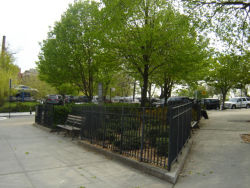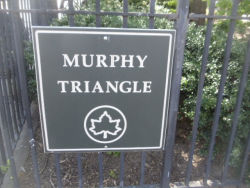Murphy Triangle
Murphy Square
Arthur H. Murphy (1868-1922) was the first Democratic County Chairman in the Bronx, a position later held by Ed “In Like Flynn” Flynn and Charles Buckley. His parents were among the thousands of Irish immigrants who crossed the Atlantic Ocean during the 19th century to escape the poverty and famine in Ireland. By the end of that century, 37 percent of the U.S. population was foreign born and the Irish comprised nearly a fourth of that number. They soon gained a foothold in the Tammany Hall wing of the Democratic Party and dominated New York politics well into the 20th century. It was as part of this organization that Arthur Murphy became a leading figure in the New York political landscape.
Born in Manhattan in 1868, Murphy moved to the Tremont section of the Bronx in 1893, where the Irish began living and working as farmhands in the early 19th century. Their numbers increased appreciably when work began on the Croton Aqueduct and the High Bridge. As a close-knit Irish community developed in the Fordham and Tremont areas, Catholic churches flourished, and local taverns became centers of social and political life much like the pubs back home in Ireland. Aside from his official duties, Arthur Murphy presided over a Democratic club that met in a tavern that he owned near the Bronx Borough Hall.
After losing an election for Bronx Borough President, he was elected to the Board of Aldermen (the predecessor of the City Council). He become the protégé of Charles Murphy (1858-1924) (no relation), the leader of the Tammany Hall political machine. Charles Murphy, called the most effective politician in the city’s history, had launched the political careers of Al Smith and Senator Robert F. Wagner, among others. (The phrase “in like Flynn” stems from the sense of inevitability that Flynn, as Charles Murphy’s choice, would succeed Arthur Murphy as the County Chairman). When the Bronx became a separate county in 1914, many at Tammany Hall were apprehensive about creating a new organization there, fearing it would be difficult to control. Charles Murphy assured his fellow Democrats that with Arthur Murphy at the helm, loyalty wouldn’t pose a problem.
Arthur Murphy fulfilled his mentor’s promise and retained his post as Bronx County Democratic Chairman until his death in 1922. His funeral is described in an obituary in the New York Times as “one of the largest ever held in the county”¦ [with] more than 15,000 people [lining] the streets from Arthur Avenue and Crotona Park North, where Mr. Murphy lived, to see the funeral procession of 600 automobiles pass on its way to St. Joseph’s Church on Bathgate Avenue.” Supreme Court Justices and prominent politicians, including former Governor Al Smith, attended; and all city and county departments in the Bronx closed on February 10 in tribute to a man who set the pattern for Bronx Irishmen in politics to follow.
The two parcels of land for Arthur Murphy Square were acquired by the city in 1899 and 1901 through condemnation. Parks acquired jurisdiction in 1913. In 1926, Mayor John F. Hylan (1869 - 1936), another Charles Murphy protégé, approved a resolution by the Board of Aldermen to designate the 0.1 acre bounded by East 181st Street, 3rd Avenue, and Quarry Road as Arthur Murphy Square Park. It is just a few blocks from the house on Crotona Park North where Arthur Murphy lived.
Check out your park's Vital Signs
Clean & Safe
Green & Resilient
Empowered & Engaged Users
Share your feedback or learn more about how this park is part of a
Vital Park System




